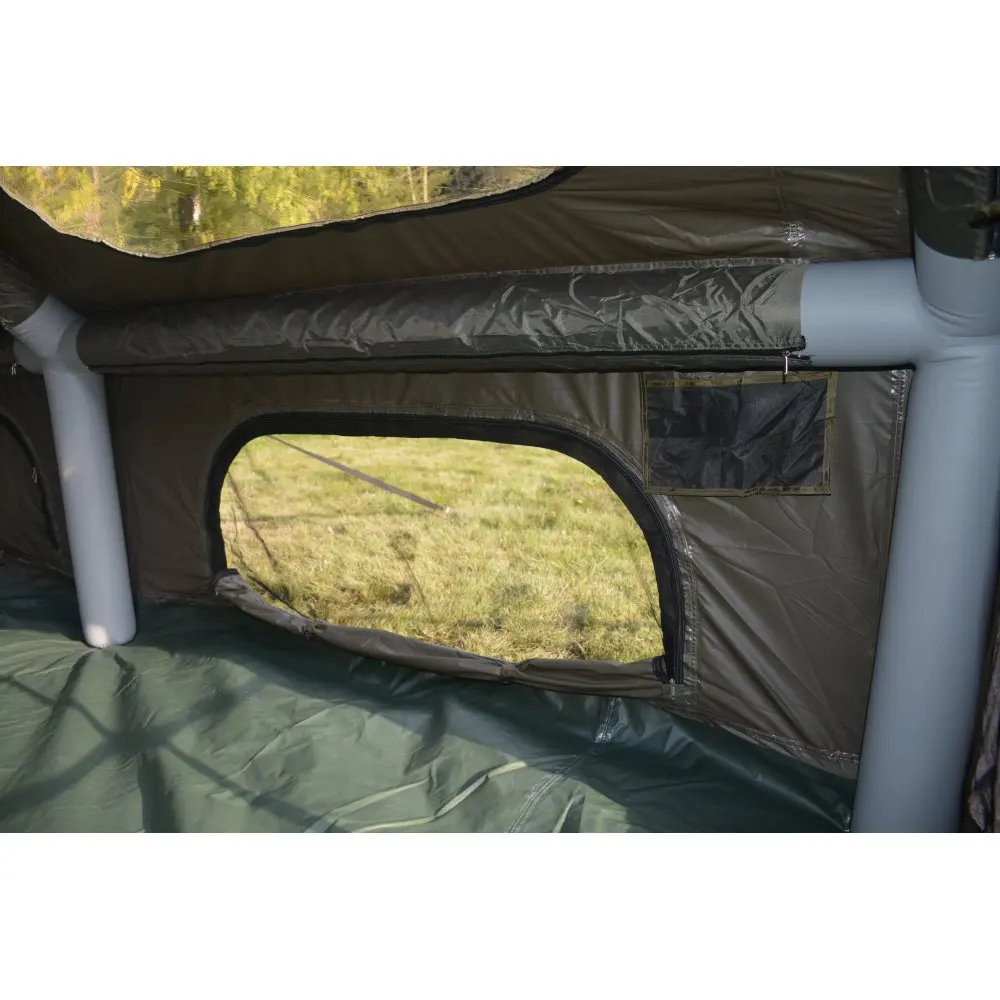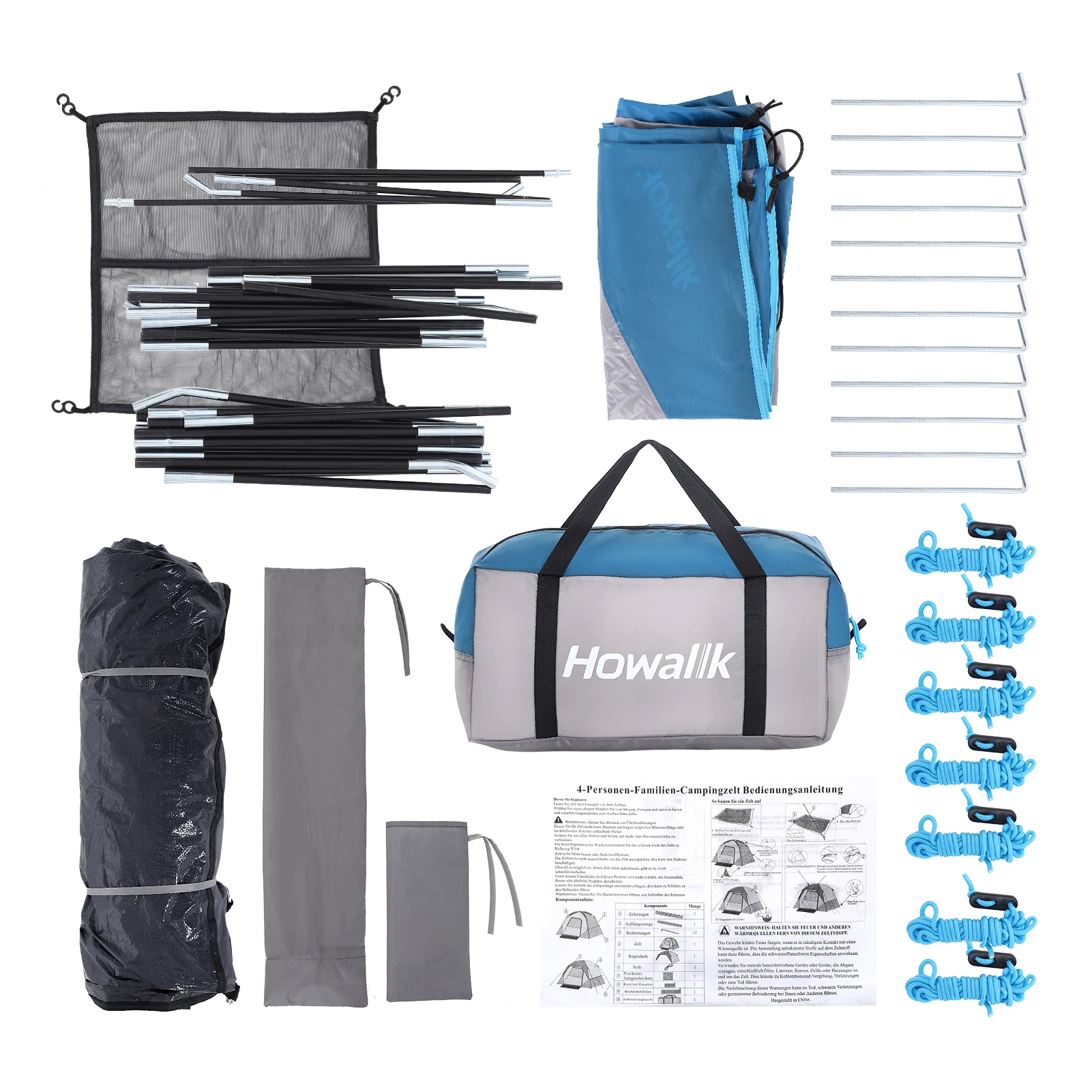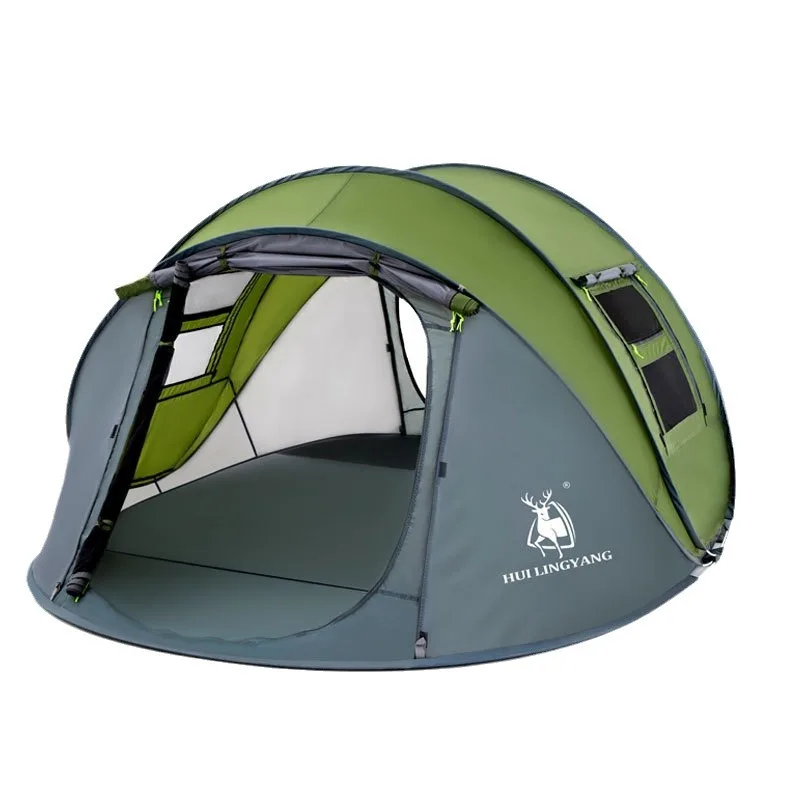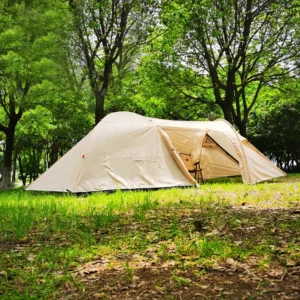Introduction: Why Weather Protection Matters for Every Camper
Weather resistance in camping tents refers to how well they withstand rain, wind, and harsh environmental conditions, while durability indicates their ability to maintain this performance over time without breaking down. These two qualities form the foundation of a reliable camping shelter that can protect you regardless of what Mother Nature throws your way.
The connection between your tent’s weather protection capabilities and your overall camping experience cannot be overstated. Even a short weekend trip can quickly turn miserable when unexpected rain seeps through fabric, winds collapse your structure, or UV exposure deteriorates your shelter. Environmental challenges like these test every tent’s limits and separate truly dependable gear from the rest.
Choosing a tent with proper weather resistance isn’t just about comfort—it’s also about safety and financial sense. Quality weather-resistant tents might cost more initially, but they prevent potentially dangerous situations and ultimately save money by not needing frequent replacement. The importance of durable tents for all seasons becomes particularly clear when you’re miles from shelter and dark clouds gather overhead.
In this guide, we’ll explore everything from waterproofing technologies to fabric choices, helping you understand how weather resistance and durability work together to create a reliable outdoor shelter.
Understanding Waterproofing: Keeping You Dry in Any Conditions
The most basic requirement of any camping tent is keeping you dry, but not all waterproofing is created equal. Understanding the technical aspects helps you select a tent that matches your specific needs.
Hydrostatic Head (HH) Rating Explained
Hydrostatic Head measures water resistance by determining how much water pressure fabric can withstand before leaking. Measured in millimeters, this rating represents the height of a water column that can be placed on the fabric before water seeps through.
- 1500mm-2000mm: Sufficient for light rain and brief showers
- 3000mm-4000mm: Handles moderate to heavy rainfall
- 5000mm+: Stands up to sustained heavy downpours
- Groundsheets: Typically need 5000mm-10000mm+ due to ground pressure when kneeling or storing gear
Many campers don’t realize that a tent that performs perfectly in a light summer shower might completely fail during an extended rainstorm. The difference between staying comfortably dry or ending up in a puddle often comes down to understanding these tent waterproof ratings.
Essential Waterproof Coatings and Treatments
Tent fabrics rely on specialized coatings to achieve their water-resistant properties:
Polyurethane (PU) Coatings: The most common and affordable waterproofing treatment, applied as a layer on the inside of tent fabrics. Effective but may degrade over time with exposure to humidity.
Silicone Treatments: Premium waterproofing applied to nylon (Silnylon) or polyester (Silpoly) that creates a highly water-repellent surface allowing water to bead and roll off. More durable and longer-lasting than PU but comes at a higher price point.
DWR (Durable Water Repellent): A surface treatment that prevents fabric saturation by causing water to form beads that roll off. Requires periodic reapplication as it wears off with use.
Critical Construction Elements for Maximum Waterproofing
Beyond fabric treatments, several construction features are essential for true waterproofing:
Seam Sealing: Since needle holes from stitching create natural water entry points, proper seam sealing is critical. Taped seams have waterproof tape applied over stitching, while welded seams use heat or ultrasonic bonding for an even stronger waterproof connection.
Bathtub Floor Design: This construction style extends waterproof floor material up the tent walls (typically 3-6 inches), creating a “tub” effect that prevents splashing or flowing ground water from entering.
Rainfly Coverage: A full coverage rainfly that extends close to the ground provides superior protection compared to partial coverage designs. The gap between fly and ground should ideally be small enough to prevent wind-driven rain from entering.
When shopping for your next adventure, consider exploring waterproof camping tent options that incorporate these essential features to ensure you stay dry regardless of conditions.
Wind Resistance: Keeping Your Shelter Standing When It Blows
While water resistance might be the first consideration for many campers, wind resistance is equally important. Nothing undermines a camping trip faster than a collapsed tent during a nighttime storm.
Tent Designs and Wind Performance
Different tent shapes handle wind very differently:
| Tent Design | Wind Performance | Best Wind Direction | Stability Rating |
|---|---|---|---|
| Dome | Good all-around performance | Multi-directional | Medium-High |
| Tunnel | Excellent when properly oriented | End-on to wind | High (when oriented correctly) |
| Geodesic | Superior stability in all directions | Multi-directional | Very High |
| Cabin | Most vulnerable to wind | Limited wind resistance | Low-Medium |
Dome camping tent designs offer a good balance of stability and usability for most conditions, with their curved poles distributing wind force across the structure. Tunnel tents excel when properly oriented with their narrower end facing the wind but perform poorly when wind hits from the side. Geodesic and semi-geodesic designs, with their multiple pole crossing points, provide the greatest stability in unpredictable or extreme conditions.
Cabin tents, while spacious and comfortable, typically have tall, vertical walls that catch wind like sails. These designs require extra attention to guying out and should be used in more sheltered locations.
Pole Materials and Impact on Stability
The skeleton of your tent plays a crucial role in wind resistance:
Aluminum Alloys: Offer the best strength-to-weight ratio for most camping conditions. They flex under pressure without breaking and return to shape when the wind subsides. Premium tents often use aerospace-grade aluminum for maximum strength.
Fiberglass: Common in budget tents, these poles are heavier than aluminum and more prone to shattering under extreme stress. While adequate for mild conditions, they’re not ideal for windy environments.
Carbon Fiber: Ultra-lightweight and strong, these premium poles are found in high-end backpacking and mountaineering tents. They provide excellent stability but come at a significantly higher price point.
Understanding wind resistance in alpine tents becomes particularly important when camping in exposed areas where sudden gusts can appear without warning.
Strategic Guy Line Usage
Even the best-designed tent requires proper guying out for maximum wind resistance:
Tension and Angle: Guy lines should be taut and ideally at a 45-degree angle to the tent for optimal support.
Attachment Points: Use all provided guy points in windy conditions, not just corner ones.
Appropriate Stakes: Match your stakes to your ground conditions—longer, Y-shaped stakes for soft soil; robust, nail-type stakes for hard ground.
Pre-emptive Setup: Don’t wait for the wind to pick up. Set up all guy lines when pitching your tent, even if conditions seem calm.
Well-designed tents include multiple guy-out points, reflective cord for nighttime visibility, and tensioners that make adjustments easy even with cold hands.
Condensation Management: The Overlooked Weather Challenge
While keeping outside moisture at bay is important, managing moisture generated inside your tent is equally crucial. Condensation occurs when warm, moist air (from breathing, wet gear, or cooking) meets cool tent surfaces, forming water droplets that can drip onto you and your gear.
This creates the condensation paradox: highly waterproof fabrics often have poor breathability, trapping moisture inside. Finding the right balance is essential for comfortable camping.
Effective ventilation systems combat condensation through:
- Strategically Placed Mesh Panels: Allow moisture vapor to escape without compromising weather protection
- High/Low Ventilation Design: Creates a chimney effect where warm, moist air rises and exits through upper vents while cooler, drier air enters through lower vents
- Adjustable Venting Options: Allow you to fine-tune airflow based on conditions
Double-wall tents generally manage condensation better than single-wall designs because they create a buffer zone between the inner breathable tent body and the waterproof rainfly. This design allows moisture to pass through the inner tent and escape or collect on the underside of the rainfly rather than dripping directly onto occupants.
For those camping in varied conditions where condensation management becomes particularly important, 4-season winter 2-person tents often feature sophisticated ventilation systems designed to balance weather protection with moisture management.
Fabric Materials: The Foundation of Weather Durability
The materials used in tent construction form the foundation of both immediate weather protection and long-term durability. Each fabric has distinct properties that determine performance in different conditions.
Common Tent Fabrics and Weather Performance
Polyester: Generally less expensive than nylon and offers excellent UV resistance, maintaining strength even after prolonged sun exposure. It absorbs less water than nylon, so it doesn’t sag when wet and dries faster. However, it typically has lower tear strength.
Nylon: Offers superior strength-to-weight ratio, making it ideal for backpacking tents. However, it degrades faster under UV exposure and absorbs water, causing sagging when wet. Nylon tents typically require re-tensioning after rainfall.
Canvas/Polycotton: Traditional tent materials that offer excellent breathability and durability. When properly weathered, they swell when wet to create a naturally waterproof barrier. Their downside includes heavier weight, longer drying times, and susceptibility to mold if stored damp.
Dyneema/Cuben Fiber: Ultra-lightweight, waterproof composites used in high-end backpacking tents. Extraordinarily strong for their weight and inherently waterproof without coatings. The main drawbacks are high cost and poor breathability.
Understanding the most durable tent material options helps you make an informed choice based on your specific camping needs.
Understanding Technical Fabric Specifications
Denier (D) Rating: Measures the thickness of individual threads in the fabric. Higher denier indicates thicker threads and generally stronger, more durable fabric, though at the cost of increased weight. Typical tent fabrics range from ultralight 10D to robust 70D+ materials.
Thread Count: Refers to the density of threads per square inch. Higher thread counts generally create stronger, more weather-resistant fabrics with better tear strength.
Ripstop Construction: Features a reinforcing technique that incorporates thicker threads in a grid pattern throughout the fabric. This prevents tears from spreading, significantly enhancing durability without adding substantial weight.

For traditional camping where weight is less of a concern, canvas camping tent options provide exceptional durability and a classic outdoor experience with natural temperature regulation properties.
Construction Quality: Where Weather Resistance Meets Durability
The finest materials can fail if poorly constructed. Quality construction transforms good materials into a reliable shelter that performs consistently in challenging conditions and lasts for years.
Critical Construction Elements for Long-Term Durability
Seam Construction: High-quality tents feature flat-felled or lap-felled seams that enclose raw edges completely, reducing the chance of fraying and water penetration. Double stitching provides additional strength at critical stress points.
Reinforcements: Durable tents include extra fabric reinforcement at stress points like corners, pole attachment points, and doorways where wear occurs most frequently.
Pole Attachment Systems: Sleeves distribute tension more evenly across fabric but can be harder to set up. Clips offer easier setup and better ventilation but may create stress points. The best tents use a combination of both systems, with sleeves at critical stress areas and clips elsewhere.
Floor Design: Beyond thickness, look for reinforced patterns or “footprint” areas where wear is most likely. Some premium tents feature “bathtub” floors with robust waterproof material extending 3-6 inches up the tent walls.
Hardware Components Affecting Weather Resistance
Zippers: YKK zippers remain the industry standard for reliability. Weather-resistant zippers feature protective flaps, waterproof coatings, or reverse coil designs that place the zipper teeth facing inward for protection from elements.
Guy Line Attachments: Should be reinforced and ideally attached through webbing to the internal frame or pole structure, not just sewn to the fabric surface.
Stake Loops: Look for heavy-duty webbing with box-stitched attachment points rather than simple fabric loops that can tear under tension.
Internal Tensioning Systems: Feature adjustable straps or cord systems that allow you to maintain optimal tent shape as fabrics stretch or sag due to weather conditions.
Four-season tents built for durability showcase these construction elements at their finest, designed to withstand the most challenging conditions while maintaining structural integrity year after year.
Choosing the Right Tent: Matching Weather Protection to Your Needs
With an understanding of technical specifications and construction features, the final step is matching these elements to your specific camping needs.
Understanding Tent Seasonality Ratings
3-Season Tents: Designed for spring, summer, and fall use in relatively mild conditions. They balance ventilation, weight, and moderate weather protection with mesh panels for airflow and lightweight materials. Ideal for temperatures above freezing with occasional rainfall.
3-4 Season (Extended Season) Tents: Feature less mesh and more fabric body coverage than standard 3-season tents, allowing them to retain more warmth. They handle light snow and colder temperatures but aren’t suitable for harsh winter conditions.
4-Season (Mountaineering) Tents: Built for year-round use, including winter camping and moderate alpine conditions. They feature stronger pole structures, less mesh, and more robust fabrics to handle snow loads and higher winds.
Expedition Tents: The ultimate in weather protection, designed specifically for extreme environments like high altitude climbing or polar expeditions. These tents prioritize strength and protection above all else, including comfort and weight considerations.
Assessing Your Specific Camping Needs
Consider these factors when selecting your tent’s weather protection level:
Environment: Desert camping emphasizes UV protection and ventilation; forest camping may focus on durability against fallen branches; alpine requires wind resistance and potentially snow-load capacity.
Trip Duration: Longer trips generally benefit from more durable construction as repairs may be difficult in remote locations.
Group Size: Larger tents typically have more surface area exposed to wind and may require stronger materials and construction.
Transportation Method: Car camping allows heavier, more durable options while backpacking necessitates lightweight designs that still offer adequate protection.

For those facing truly challenging conditions, heavy-duty 4-season tent options provide maximum protection against extreme weather while maintaining livable space.
Lightweight Backpacking Tent, Ultralight Backpacking Tent, Waterproof Backpacking Tent
$391.05 Select options This product has multiple variants. The options may be chosen on the product pageHeavy Duty 4 Season Tent, Mountaineering Tent, Winter Camping Tent
$870.40 Select options This product has multiple variants. The options may be chosen on the product pageCompact Backpacking Tent, Lightweight Backpacking Tent, Waterproof Camping Tent
$335.52 Select options This product has multiple variants. The options may be chosen on the product pageUltralight Backpacking Tent, Ultralight Dome Tent, Winter Camping Tent
Price range: $369.63 through $370.07 Select options This product has multiple variants. The options may be chosen on the product pageCamping Tent with Vestibule, Waterproof Camping Tent
Price range: $407.89 through $479.48 Select options This product has multiple variants. The options may be chosen on the product pageHeavy Duty 4 Season Tent, Ultralight Freestanding Tent, Winter Camping Tent
$3,722.66 Select options This product has multiple variants. The options may be chosen on the product page
Understanding how to properly prepare for challenging weather conditions makes navigating nature’s fury with durable tents much more manageable, even for less experienced campers.
Maintenance and Care: Extending Weather Protection Longevity
Even the most weather-resistant tent requires proper care to maintain its protective capabilities over time.
Essential Cleaning and Drying Protocols
Field Cleaning: Shake out dirt and debris daily during trips. Spot clean with plain water and a soft cloth for mud or tree sap.
Post-Trip Cleaning: Set up your tent at home and clean with mild soap and water (never use harsh detergents or washing machines). Rinse thoroughly and allow to dry completely before storage.
Complete Drying: Perhaps the most critical step—never store a tent with even slight dampness, as this leads to mildew and can degrade waterproof coatings. Air dry in a shaded area, as direct sunlight can damage UV-sensitive fabrics.
Storage Best Practices
Loose Storage: Avoid long-term compression in stuff sacks, which can create permanent creases where waterproofing can fail. Store loosely in a cotton storage sack or pillowcase.
Climate Control: Store in a cool, dry place away from direct sunlight, heating sources, and areas with fluctuating humidity.
Folding Technique: Avoid folding along the same lines repeatedly, as this creates permanent creases and potential failure points in the waterproof coating.
Reapplication of Waterproofing Treatments
When to Reapply: When you notice water no longer beading on the surface or seeping through previous waterproof areas, it’s time to reapply treatments.
Product Selection: Use appropriate treatments for your specific tent material—silicone-based products for silicone-treated fabrics, urethane-based products for PU-coated tents.
Seam Sealer: Focus on seams showing signs of leaking, applying a thin, even coat according to product instructions.
Understanding all-season tent materials and their specific care requirements can significantly extend your tent’s functional lifespan and maintain its weather protection capabilities.
How Weather-Resistant Tents Perform in Extreme Conditions
Understanding performance limits helps set realistic expectations for what even high-quality tents can handle.
Severe Thunderstorms
During intense storms, even quality tents have their limits. Expect some flexibility in the structure during strong gusts—this is actually by design, allowing tents to absorb wind energy rather than fighting it rigidly. Water resistance should hold during heavy downpours, though extended extreme rainfall may eventually find weak points. Smart campers select protected sites and ensure proper setup with all guy lines deployed before storms arrive.
Cold Weather Challenges
Winter camping presents unique challenges beyond basic weather resistance. Condensation becomes particularly problematic as warm breath meets cold tent walls, potentially freezing and then melting as droplets when temperatures rise. Four-season tents handle snow load through steeper roof angles and stronger pole structures that prevent accumulation. Vestibules—those transitional spaces between the outdoors and tent interior—become critical for storing wet gear and preventing snow entry during ingress/egress.
Desert and High-UV Environments
Desert camping combines extreme heat, intense UV exposure, and occasional severe winds. Quality tents address these challenges through UV-resistant fabrics (typically polyester rather than nylon), enhanced ventilation, and robust stake/guy line systems for sudden wind gusts. Dust and sand protection requires fine mesh ventilation panels and careful zipper maintenance.
Waterproof backpacking tent options that balance weather protection with weight considerations are particularly valuable for those traveling through varied terrain where conditions can change rapidly.

Is Weather Resistance Worth the Investment for Casual Campers?
For occasional campers who only venture out a few weekends a year in fair weather, the question of how much to invest in weather protection becomes particularly relevant.
Minimum Recommended Protection
Even casual campers should look for tents with at least 1500mm hydrostatic head waterproofing, taped seams on rainflies and floors, and adequate ventilation to manage condensation. This baseline protection handles light to moderate rainfall and typical summer conditions without requiring premium pricing.
Value Proposition Analysis
Consider your camping style honestly—if you exclusively camp in fair weather and check forecasts carefully, basic weather protection may suffice. However, if you’ve ever cut trips short due to tent failure or discomfort in changing conditions, investing in better weather protection likely offers good value.
The cost difference between budget and mid-range options often amounts to just $50-100, which spread across multiple seasons of use, represents excellent value for the improved experience and extended product lifespan. Durable tents for extreme outdoor adventures might be overkill for casual use, but modest upgrades in weather protection often provide disproportionate returns in comfort and convenience.
Conclusion: Making Weather-Informed Tent Decisions
Weather resistance and durability in camping tents aren’t just technical specifications—they’re the foundation of enjoyable outdoor experiences regardless of conditions. Understanding waterproofing ratings, construction quality, and material characteristics empowers you to make informed decisions about the level of protection that matches your specific camping needs.
The most important takeaway is matching your tent’s capabilities to your typical camping conditions with a reasonable buffer for unexpected weather. A tent that leaves you wet, cold, or with damaged gear quickly proves expensive regardless of its initial price, while appropriate weather protection transforms potentially miserable situations into memorable adventures.
Quality weather-resistant tents from companies like Explore Elements represent an investment in both outdoor comfort and long-term value. By understanding the four-season tent features and benefits that contribute to weather performance, you can select gear that reliably protects you season after season, regardless of what Mother Nature has in store.







